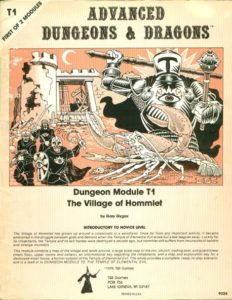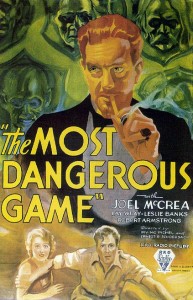
The Village of Hommlet
My previous posts on the blogs Monsters and Manuals and Grognardia led me to look back on Dungeons & Dragons, a game whose influence on me is pronounced, even if I haven’t played it since I was a teenager.
One topic blogger James Maliszewski explored in depth was “Gygaxian Naturalism,” his term for D&D’s co-creator Gary Gygax’s aesthetic sensibilities:
The intention behind Gygaxian Naturalism is to paint a picture of a “real” world, which is to say, a world that exists for reasons other than purely gaming ones. The implication is that monsters have lives of their own and thus go about their business doing various things until they encounter the player characters. … I don’t mean to imply that [D&D] is realistic in any meaningful sense, only that its fantasy follows “natural” laws of a sort, much in the way that, for example, I know that there are squirrels and raccoons and rabbits in my neighborhood who go about their business when I’m not seeing them in my yard or chasing them away from my recycling bins.
Before Grognardia I’d never heard anyone describe D&D as naturalistic, and yet the moment I read this post I knew exactly what Maliszewski was referring to. Gygax breathed an internal logic into his game. His fantasy world is a dynamic and mutable place rather than a static backdrop.
The creatures that inhabit this fantasy world don’t merely exist as wooden cut-outs in a shooting gallery. They coexist within an ecosystem. Minotaurs prefer solitary existences while goblins live in tribes. There’s a pecking order. In Against the Giants, the players discover the Hill Giants answer to the Frost Giants, and the Frost Giants answer to the Fire Giants…and all the giants answer to the elves underground.
Gygax’s The Village of Hommlet is an exemplar of D&D naturalism. The village is a medieval Winesburg, Ohio of nosy innkeepers and petty intrigues and split alliances—oh, and there’s an evil-worshiping death cult ten miles outside of town. One reviewer notes Hommlet “is a place with history and its history shapes and affects its layout, mood and inhabitants.”
Those inhabitants don’t exist merely to impart exposition or direct the adventurers to the dungeon entrance. They have ambitions, suspicions, and secrets. They share useful and baseless rumors. A widower farmer and his spinster daughter live in town. They are the black sheep of the village and not well-liked. They’ve stashed seventy-three silver coins in the hollow of a tree—there could be a story within all these details, a story within the larger story. Another farmer’s son likes his brew a bit too much and will wag his tongue if drunk under the table, while the town brewer’s nephew can hold his ale and then some. One elderly farmer is ex-military but would rather talk about any matter other than fighting. More question marks, more history.
And yet, it’s possible, even likely, none of these inhabitants or their situations will be faced by the players. Like Hemingway’s iceberg, Gygax’s inclusion of these details make the setting richer even if little of it is presented in-game. The players may never meet the farmer’s daughter, they may never drink at the inn, and they may never become involved in Hommlet’s inner squabbles. But if these details do become relevant, the game referee is expected to honor the villagers’ best interests and play to their strengths and weaknesses the way a character actor might develop a backstory for his brief role.
How does this correspond to naturalism in literature, especially American literature? In work like McTeague or The Awakening, characters are cursed to accede to the drives of base instincts rather than follow established civilized norms. Greed is innate. Lust cannot be tamed. (Brew cannot be avoided.)
Naturalism presents “nature as an indifferent force acting on the lives of human beings.” Gygaxian Naturalism certainly meets this criteria. Man is of no concern not only to animals, but also bugbears, dragons, and gods, demigods, and demons. The infamous D&D dice act as passionless Fates that hold the players’ futures in their hands. The players start as insignificant creatures in the great chain of being, only becoming a problem when they burst into a lair bearing swords and torches. A player character’s death is mourned by few, if anyone.
When I was in grade school, two of my favorite short stores were “Leinigen Versus the Ants” and “The Most Dangerous Game.” Both are high naturalism, and both are very D&D-like in their telling.
In the introduction to The Village of Hommlet, Gygax writes “there are wheels within wheels in Hommlet and the lands around, and behind each character there is another, the circles growing wider and the figures shadowy but very powerful.” It’s not deep, nuanced stuff, but it’s enough sophistication to give players a lurking sense they are but minor actors in a larger drama. Gygaxian Naturalism is a big reason why playing D&D felt like acting within a story rather than playing a sword & sorcery video game sans computer.
